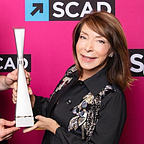Lights, Camera, Education!
In part one of this series , I wrote about an unexpected discovery while reading the latest round of SCAD student evaluation comments: Above all else, today’s students want and expect their courses and professors to be engaging. In comment after comment, our students declared engagement to be the defining element in any great course:
Our professor engaged us every day with new ways of looking at the course subject matter.
I found the class so engaging, from start to finish. At no point was I ever bored.
This was by far the most engaging course I’ve ever taken, at any university.
All very positive comments, yes, but what does the word mean? Is engaging merely a fresh synonym for enjoyable or interesting, or is there something deeper at work in the ubiquity of this word and its sudden appearance in thousands of student evaluation surveys? To answer this question, I commissioned our in-house research team to mine the data, convene a focus group or two, and find answers. According to our research, the courses that SCAD students most often describe as “engaging” tend to demonstrate four essential qualities.
1. Engaging courses are almost always taught by professors who maintain frequent communication.
SCAD students revealed that their most engaging professors often arrived to class 15 to 20 minutes early, to set up the classroom (projector, desks, handouts) — and stayed late to answer student questions about assignments, rather than rushing off to the next meeting. Their favorite professors also demonstrated availability via email and through BlackBoard, responding within minutes to student messages and assuaging anxiety about imminent deadlines. Clear and consistent communication shows students that faculty members care.
2. The most engaging professors are simultaneously authoritative and approachable.
SCAD students said their best professors are like choirmasters, demonstrating confident control of the class environment. “[Our professor] gave it to us straight, what the business of animation is really like. He treated class like a studio, and it was awesome. He did not soften his criticism but did it in a way that really made you see what he was talking about.” Faculty members are the experts: They hold the terminal degrees, experience, credits and acclaim that merit students’ attention. Students deeply desire this knowledge. The best faculty hold nothing back. They share what they know. One SCAD painting student wrote, “The hard teachers are the ones who stay with me. I don’t remember a professor if I floated through their class.” Students expect rigor and a challenging environment that’s free of cynicism and negativity. “The challenging teachers are the ones who care most,” a SCAD interior design student wrote.
3. The most engaging courses are free of extraneous and disruptive technologies.
Many SCAD students described their most engaging classes as lively and loud, with lots of excited chatter, questions, answers, debates. When pushed further in the focus group, students revealed what fosters this liveliness: a lack of distraction. SCAD is a hyper-connected university, but our faculty understand the place of technology in the classroom: Tech must support and advance learning, or be removed. “We weren’t allowed to be on our phones or laptops,” one student wrote, “unless they were necessary for the lesson. It was hard at first, but I get it now.” Students actually voice concern about valuable class time being taken up with online videos that could be viewed outside of class — mostly because when they’re in the classroom, what they most desire to see is their professor, front and center. In our connected-but-isolated world, the best professors teach students what real presence looks like.
4. The most engaging professors create lesson plans that utilize a three-act structure.
Generally, students are averse to any course that relies too heavily on a single mode of instruction. What students want, across majors and disciplines, is a healthy mix of three elements: lecture, demonstration, and application. Ultimately, the lesson of engagement is that students deeply desire faculty members to be the producers, directors, and stars of their classrooms. (After all, a SCAD class meeting lasts 150 minutes — about the length of a Spielberg film.) The ideal lecture length, according to our research, is 20–45 minutes, and these didactic presentations are most effective when followed immediately by demonstrations and examples of the content — after which, students are invited to apply those ideas in their own work and mediums. Students must hear, see, and do! Remove any one of those three elements and learning falters. Employ all three, and you’ve hit the sweet spot of engagement.
It pays to listen to students, in the classroom and in their evaluations. You’ll learn something new, and isn’t that what reading is all about? In fact, I’m currently looking at a stack of our latest student evaluations from the end of the academic year. Guess I know what I’m reading this summer. It’s a page-turner!
